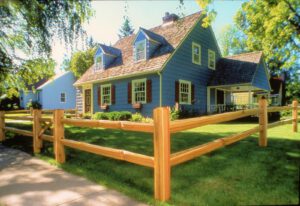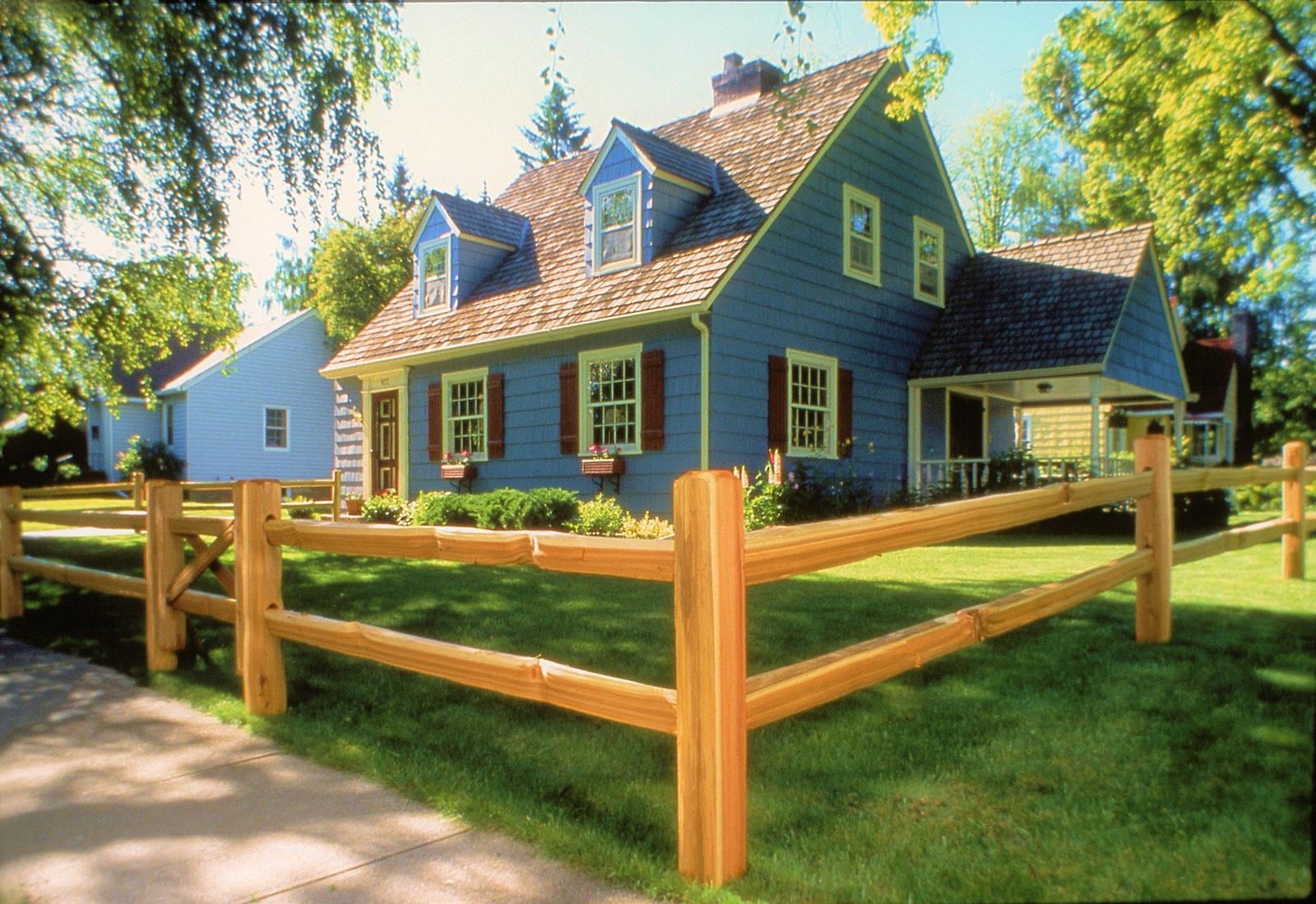Split-rail fencing at Charlotte Fence Company provides a classic, rustic look that pays homage to rural living. Typically made of cedar, these fences can complement any home and provide a sense of charm that stands out.
These fences are also relatively easy for homeowners to install. This article will discuss different types of split rail fences and their benefits.
Cedar split rail fences are one of the most cost-effective styles for defining property boundaries, decorating yard areas, and fencing in livestock and horses. This rustic style is also easy to install, making it an ideal do-it-yourself project. Posts are set directly into the ground, approximately. 30″ deep without any concrete. Using a tamping bar, the dirt is compacted around the posts to make it secure for use.
Cedar is one of the most durable types of lumber available for split rail fences and is naturally resistant to decay, insects, and fungus. Its natural color allows it to be left untreated or stained to match the decor of your home and other structures on your property. Cedar is also extremely lightweight, allowing it to be easily handled and used to construct this type of fence.
Pine is another popular option for split-rail fencing. Although it is less expensive than cedar, it isn’t as durable and may require more maintenance over time. Additionally, pine has a yellowish color that may not appeal to all homeowners.
In addition to determining the right lumber to use for your split rail fence, you’ll also want to consider factors like the amount of material needed and the total installation cost. While you can save money by purchasing your own materials, hiring a professional can be the best way to ensure that your fence is built properly and safely.
When estimating the cost of installing your cedar split rail fence, you’ll need to take several factors into account, including:
The amount of materials needed will be the largest factor in determining your fence’s cost. If you’re fencing a large area, the cost will increase for each additional linear foot of fencing. The number of rails per section will also affect the overall cost. Choosing a 3-rail fence instead of a 2-rail fence will cost more, but it will be sturdier and better suited for your needs.
Other factors that will influence your final fencing costs include the terrain where your split rail fence is being installed, the type of soil you’re working with, and the time of year when you’re purchasing your materials. Homeowners who are interested in saving money on their fence installation costs should shop around and compare quotes before making a decision.
Black Locust
Wood split rail fences are one of the most traditional fencing styles, and they are a great option for those looking for a rustic and natural-looking fence. These fences are typically made using black locust posts with hard wood rails. They can be used for a number of purposes, including containing livestock and defining property boundaries. The fences also provide a scenic backdrop for property views. There are several advantages to a wood split rail fence, including its durability and low maintenance.
Black locust split rail fences are very strong, and they can withstand the elements for decades without the need for treatment or chemical applications. They are also rot-resistant and insect-proof. This makes them an excellent choice for a farm or ranch fence. Additionally, the black locust split rails have a distinct greenish-yellow tint when first cut that will darken to a golden color over time.
Cedar is another common choice for a wood split rail fence, but it can be more expensive than other types of lumber. Additionally, cedar is not as durable as black locust, and it is more susceptible to rotting in wet soil conditions. However, it is an attractive option for those who want a classic cedar fence, and the wood’s natural ability to resist moisture and insects makes it a good choice in many climates.
Western red cedar is also a common type of split rail fence, and it is an excellent choice for those who want a fence that will last for years without the need for chemical treatments. These fences are also resistant to rot, and they will not lose their shape or strength over time.
Compared to western red cedar, pressure-treated yellow pine is less expensive, but it is not as durable. This type of wood can be treated with chemicals to fight rot and other destructive forces, but it is not as strong as either black locust or black locust split rails.
Depending on the region, black locust can be purchased at a moderate price. It is a dense wood, and it is often mixed with other hardwoods to create a more affordable fence. It can also be purchased pre-treated to combat the effects of weathering and aging.
Two-Rail
Split-rail fencing is a great way to add a rustic and natural look to your property. It’s also relatively inexpensive, making it a good choice for homeowners who want to keep their pets and kids safe on their property without breaking the bank. However, there are a few things you should know before having this type of fence installed.
A two-rail split-rail fence is a common choice for residential properties and country gardens. This type of fence provides clear boundary definition and works well with a variety of home styles and designs. Additionally, it doesn’t block your views or landscapes like other types of fencing can, allowing you to enjoy the beauty of nature that surrounds you.
Most often, this style of fence is made of oak, which has a beautiful grain pattern and natural color that will hold up to the elements over time. Cedar is also a popular material for split rail fencing, but it can be more expensive than oak.
Another option for a split rail fence is high-quality poplar, which has a similar appearance to cedar but is more affordable. If using poplar, make sure it’s pressure-treated to increase durability and longevity.
In addition to the cost of materials, there are other factors that can affect the total cost of your split-rail fence. For example, the amount of labor involved will play a role in the overall price. If you choose to have a professional install your fence, it’s important to get several quotes before choosing a contractor. This will help you avoid overpaying and ensure that you’re getting the best value for your money.
One of the most significant ways to lower your split rail fence cost per foot is to stain or paint the wood. This will protect the wood from weathering and rot and prolong its life. Additionally, it can help to give the fence a more appealing color, which will attract less attention from unwanted pests and weeds.
Another way to save on the cost of a split rail fence is to install it yourself. While this can be a challenging project for beginners, it is not impossible. Depending on the size of your yard and the number of split rail posts needed, this can be an affordable option for homeowners who have the time and tools necessary to complete the project.
Wire Mesh
Split-rail fencing gives your property a pastoral feel that evokes images of horses and cowboys. However, the wide gaps between split pickets can leave your garden vulnerable to smaller animals like foxes and coyotes. To keep these creatures out of your garden or prevent them from attacking livestock, you can add wire mesh to your split-rail fence. Wire mesh is relatively inexpensive and can be easily attached to your existing split rail fence, though you may want to consider having a contractor do it for you.
Whether you’re installing a wood, composite, or metal split rail fence, the price is going to be dependent on how much of your property you’re fencing in and what material you choose. Homeowners who have construction experience can often save money on their split rail fence installation by doing it themselves rather than hiring a professional contractor. However, this isn’t always possible for homeowners who aren’t comfortable working with power tools.
When determining your split rail fence cost, you should start by getting a quote on how much materials and labor are going to cost for the project. To get a more accurate estimate, enter the specific details of your project into our fence calculator. Once you’ve determined the amount of material and labor your project will require, you can begin planning the construction.
Before starting to build your fence, it’s a good idea to set, plumb, and brace your corner posts first. This will give you fixed points to work off of, and it will help ensure that your fence is perfectly straight. You should also use a level to make sure that each post is evenly spaced and has an even slope.
Once your corner posts are set, it’s time to begin constructing the rest of your fence. It’s important to start with a strong foundation, so be sure to use concrete or stakes in your holes. When adding stakes, it’s a good idea to use steel ones rather than wooden ones. These stakes will be more durable and last longer than wooden ones.

